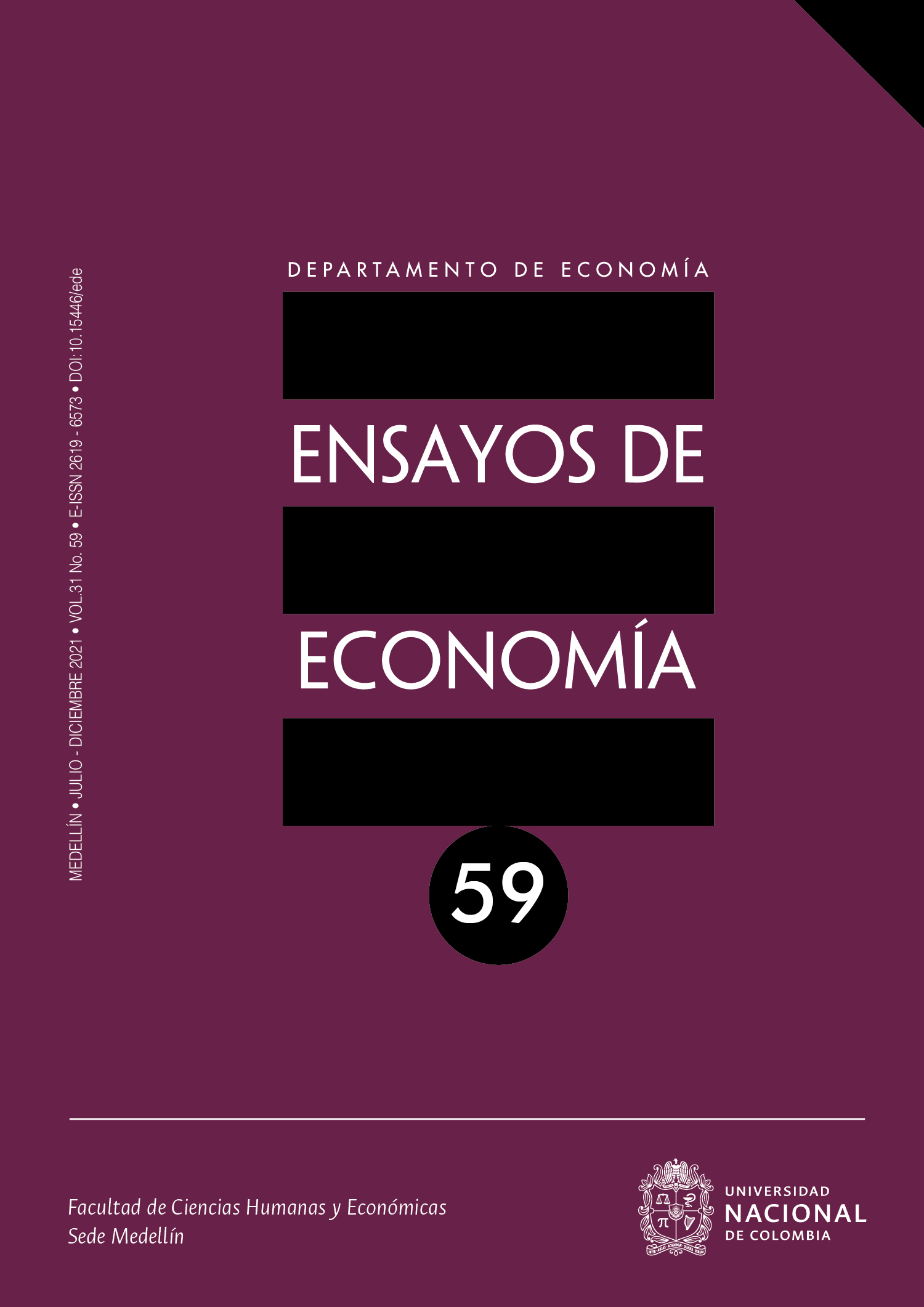Proximidades en el aprendizaje tecnológico: aportes metodológicos para el estudio de los entramados locales en América Latina
Proximities in Technological Learning: Methodological Contributions for the Study of Local Frameworks in Latin America
DOI:
https://doi.org/10.15446/ede.v31n59.93273Palabras clave:
proximidades, innovación, entramados locales, aprendizaje tecnológico, metodología económica (es)proximities, innovation, technological learning, local frameworks, economic methodology (en)
Descargas
La difusión de nuevas tecnologías en el marco de una creciente internacionalización de la producción representa un desafío para las economías latinoamericanas, debido a su impacto en las trayectorias de especialización y diversificación de los entramados productivos locales y la intensificación de procesos asimétricos e incompletos de aprendizaje. El enfoque de las proximidades ofrece elementos teórico-metodológicos útiles para aprehender el rol de las condiciones geográficas y no geográficas que operan en los procesos de aprendizaje e innovación. Sin embargo, este enfoque ha sido desarrollado con base en estudios teóricos y empíricos que analizan los procesos innovativos en países desarrollados y cuestionan la relevancia de la proximidad geográfica en estos procesos. Este artículo propone reflexionar sobre este enfoque y repensar su abordaje conceptual y su diseño metodológico para analizar procesos de innovación en los entramados tecno-productivos de América Latina. El análisis muestra que el estudio de este fenómeno —desde el enfoque de las proximidades— debe considerar su carácter complejo e indisociable del contexto y, por lo tanto, la importancia del estudio de caso como método de investigación, así como la tensión existente entre las dinámicas globales, locales y el papel ineludible de los Estados en estos procesos.
The diffusion of new technology within the framework of a growing internationalization of production represents a challenge for Latin American economies, due to their impact on the specialization and diversification trajectories of the local production frameworks and the intensification of asymmetrical and incomplete educational processes. A proximities approach offers theoretical-methodological elements that are useful in grasping the role of geographic and non-geographic conditions at work in learning and innovation processes. However, this approach has been developed based on theoretical and empirical studies that analyze innovation processes in developed countries and question the relevance of geographical proximity in these processes. This article proposes a reflection on this approach and rethinking its conceptual approach and methodological design to analyze innovation processes in technical-production frameworks in Latin America. This analysis shows that the study of this phenomenon – from a proximities approach- should consider its complex character, which is impossible to disassociate from context and, as such, the importance of the case study as research method, as well as the exiting tensions among global and local dynamics and the State’s unavoidable role in these processes.
Referencias
Aguilera, A., Lethiais, V., & Rallet, A. (2012). Spatial and Non-spatial Proximities in Inter-firm Relations: An Empirical Analysis. Industry and Innovation, 19(3), 187–202. https://doi.org/10.1080/13662716.2012.669609
Aldieri, L. (2011). Technological and Geographical Proximity Effects on Knowledge Spillovers: Evidence from the US Patent Citations. Economics of Innovation and New Technology, 20(6), 597–607. https://doi.org/10.1080/10438599.2011.554632
Balland, P.A., De Vaan, M., & Boschma, R. (2013). The Dynamics of Interfirm Networks along the Industry Life Cycle: The Case of the Global Video Game Industry, 1987-2007. Journal of Economic Geography, 13(5), 741–765. https://doi.org/10.1093/jeg/lbs023
Balland, P. A. (2012). Proximity and the Evolution of Collaboration Networks: Evidence from Research and Development Projects within the Global Navigation Satellite System (GNSS) Industry, Regional Studies, 46(6), 741-756. https://doi.org/10.1080/00343404.2010.529121
Bianchi, C. (2013). The Role of Innovation Policies in the Brazilian Health Biotechnology Regime. Latin American Business Review, 14(3/4), 309-332. https://doi.org/10.1080/10978526.2013.838060
Boschma, R. (2005). Proximity and Innovation: A Critical Assessment, Regional Studies, 39(1), 61-74. https://doi.org/10.1080/0034340052000320887
Boschma, R., & Lambooy, J. (1999). Evolutionary Economics and Economic Geography. Journal of evolutionary economics, 9(4), 411-429. https://doi.org/10.1007/s001910050089
Breschi, S., & Lissoni, F. (2001). Localised Knowledge Spillovers vs. Innovative Milieux: Knowledge “Tacitness” Reconsidered. Papers in Regional Science, 80, 255–273. https://doi.org/10.1007/PL00013627
Bresnahan, T., Gambardella, A., & Saxenian, A. (2005). Old Economy Inputs for New Economy Outcomes: Cluster Formation in the New Silicon Valleys. Clusters, Networks and Innovation, 10(4), 113–134. https://doi.org/10.1093/icc/10.4.835
Broekel, T., & Boschma, R. (2012). Knowledge Networks in the Dutch Aviation Industry: The Proximity Paradox. Journal of Economic Geography, 12(2), 409–433. https://doi.org/10.1093/jeg/lbr010
Cassiolato, J., Szapiro, M., & Lastres, H. (2002). Local System of Innovation under Strain: The Impacts of Structural Change in the Telecommunications Cluster of Campinas, Brazil. International Journal of Technology Management, 24(7), 680-704. https://doi.org/10.1504/IJTM.2002.003078
Coase, R. H., (1937). The Nature of the Firm. Economica, 4(6), 386-405. https://doi.org/10.1111/j.1468-0335.1937.tb00002.x
Cohen, W., & Levinthal, D. (1990). Absorptive Capacity: A New Perspective on Learning and Innovation. Administrative Science Quarterly, 35(1), 128-152. https://doi.org/10.2307/2393553
Cooke, P. (2001). Regional Innovation Systems, Clusters, and the Knowledge Economy. Industrial and Corporate Change, 10(4), 945–974. https://doi.org/10.1093/icc/10.4.945
Crescenzi, R., Nathan, M., & Rodríguez-Pose, A. (2016). Do Inventors Talk to Strangers? On Proximity and Collaborative Knowledge Creation. Research Policy, 45(1), 177–194. https://doi.org/10.1016/j.respol.2015.07.003
Davids, M., & Frenken, K. (2017). Proximity, Knowledge Base and the Innovation Process: Towards an Integrated Framework. Regional Studies, 52(1), 23-34. https://doi.org/10.1080/00343404.2017.1287349
Delvenne, P., & Thoreau, F. (2017). Dancing without Listening to The Music: Learning from Some Failures of The “National Innovation Systems” in Latin America. En S. Kuhlmann & G. Ordóñez-Matamoros (eds.), Research Handbook on Innovation Governance for Emerging Economies. Cheltenham (pp. 37-58). Edward Elgar Publishing. https://www.elgaronline.com/view/edcoll/9781783471904/9781783471904.00007.xml
Geldes, C., Heredia, J., Felzensztein, C., & Mora, M. (2017). Proximity as Determinant of Business Cooperation for Technological and Non-technological Innovations: A Study of an Agribusiness Cluster. Journal of Business & Industrial Marketing, 32(1),167-178. https://doi.org/10.1108/JBIM-01-2016-0003
Gereffi, G. (2013). A Global Value Chain Perspective on Industrial Policy and Development in Emerging Markets. 24 Duke Journal of Comparative & International Law, 24, 433-458. https://scholarship.law.duke.edu/cgi/viewcontent.cgi?article=1404&context=djcil
Gorenstein, S., & Gutman, G. (2016). Desarrollo y territorio: clusters tecnológicos en la periferia. Revista Política e Planeamento Regional, 3(1), 1-18. www.revistappr.com.br/artigos/publicados/DESARROLLO-y-TERRITORIO-CLUSTERS-TECNOLOGICOS-EN-LA-PERIFERIA-.pdf
Gorenstein, S., & Moltoni, L. (2011). Conocimiento, aprendizaje y proximidad en aglomeraciones industriales periféricas. Estudio de caso sobre la industria de maquinaria agrícola en la Argentina. Journal of Regional Research, 20, 73-92. https://www.redalyc.org/articulo.oa?id=28920705004
Granovetter, M. (1985). Economic Action and Social Structure: The Problem of Embeddedness. American Journal of Sociology, 91(3), 481-510. https://www.jstor.org/stable/2780199
Johnson, B. (1997). System of Innovation: Overview and Basic Concepts. En C. Edquist (ed.), Systems of Innovation: Technologies, Institutions and Organizations (pp. 36-63). Routledge Press. https://charlesedquist.files.wordpress.com/2015/06/science-technology-and-the-international-political-economy-series-charles-edquist-systems-of-innovation_-technologies-institutions-and-organizations-routledge-1997.pdf
Heringa, P., Horlings, E., Van der Zouwen, M., Van den Besselaar, P., & Van Vierssen, W. (2014). How do Dimensions of Proximity Relate to the Outcomes of Collaboration? A Survey of Knowledge-intensive Networks in the Dutch Water Sector. Economics of Innovation and New Technology, 23(7), 689–716. https://doi.org/10.1080/10438599.2014.882139
Kirat, T., & Lung, Y. (1999). Innovation and Proximity: Territories as Loci of Collective Learning Processes. European Urban and Regional Studies, 6(1), 27–39. https://doi.org/10.1177/096977649900600103
Lavarello, P., Minervini, M., & Robert, V. (2017). From Collaboration Networks for Innovation to the Development of Science and Technology Clusters. Two case studies at the National University of San Martin in Argentina. Revista Brasileira de Inovacao, 16(2), 299-324. https://doi.org/10.20396/rbi.v16i2.8650113
Lavarello, P,. & Saravia, M. (2015). La política industrial en la Argentina durante la década de 2000. CEPAL. www.cepal.org/es/publicaciones/39886-la-politica-industrial-la-argentina-durante-la-decada-2000
Lundvall, B. A. (1992). National Systems of Innovation: An Analytical Framework. Pinter Publishers.
Martin, R., & Sunley, P. (2006). Path Dependence and Regional Economic Evolution. Journal of Economic Geography, 6(4), 395-437. https://doi.org/10.1093/jeg/lbl012
Meier, M. (2011). Knowledge Management in Strategic Alliances: A Review of Empirical Evidence. International Journal of Management Reviews, 13(1), 1–23. https://doi.org/10.1111/j.1468-2370.2010.00287
Nilsen, T., & Lauvås, T. (2018). The Role of Proximity Dimensions in Facilitating University-Industry Collaboration in Peripheral Regions: Insights from a Comparative Case Study in Northern Norway. Arctic Review on Law and Politics, 9, 312–331. https://doi.org/10.23865/arctic.v9.1378
Niosi, J., & Banik, M. (2005). The Evolution and Performance of Biotechnology Regional Systems of Innovation. Cambridge Journal of Economics, 29(3), 343–357. https://doi.org/10.1093/cje/bei044
Pietrobelli, C., & Staritz, C. (2018). Upgrading, Interactive Learning, and Innovation Systems in Value Chain Interventions. The European Journal of Development Research, 30(3), 557-574. https://doi.org/10.1057/s41287-017-0112-5
Rabellotti, R., & Pietrobelli, C. (2006). Upgrading to compete. Global Value Chains, Clusters and SMEs in Latin America. Inter American Development Bank; David Rockefeller Center for Latin American Studies and Hardvard University. https://publications.iadb.org/publications/english/document/Upgrading-to-Compete-Global-Value-Chains-Clusters-and-SMEs-in-Latin-America.pdf
Rallet, A., & Torre, A. (1999). Is Geographical Proximity Necessary in the Innovation Networks in the Era of Global Economy? GeoJournal, 49, 373–380. https://doi.org/10.1023/A:1007140329027
Steinmo, M., & Rasmussen, E. (2016). How Firms Collaborate with Public Research Organizations: The Evolution of Proximity Dimensions in Successful Innovation Projects. Journal of Business Research, 69(3), 1250–1259. https://doi.org/10.1016/j.jbusres.2015.09.006
Torre, A. (2008). On the Role Played by Temporary Geographical Proximity in Knowledge Transmission. Regional Studies, 42(6), 869–889. https://doi.org/10.1080/00343400801922814
Torre, A. (2010). Jalons Pour une Analyse Dynamique des Proximités. Revue d´Economie Regionale Urbaine, 3, 409-437. https://doi.org/10.3917/reru.103.0409
Torre, A., & Rallet, A. (2005). Proximity and Localization. Regional Studies, 39(1), 47-59. https://doi.org/10.1080/0034340052000320842
Williamson, O. (1985). The Economic Institutions of Capitalism. The Free Press.
Yin, R. K. (2018). Case Study Research and Applications: Design and Methods. Sage
Cómo citar
APA
ACM
ACS
ABNT
Chicago
Harvard
IEEE
MLA
Turabian
Vancouver
Descargar cita
Licencia

Esta obra está bajo una licencia internacional Creative Commons Atribución-NoComercial-SinDerivadas 4.0.
Se autoriza la reproducción sin ánimo de lucro de los materiales, citando la fuente.


























